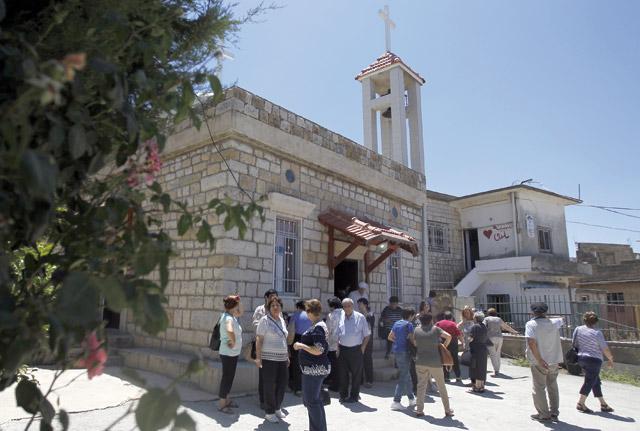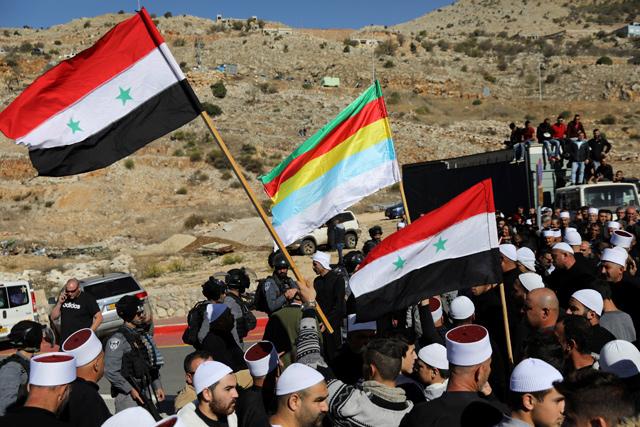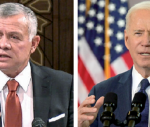You are here
Last Christians of Israeli-occupied Golan Heights endure
By AFP - Jul 01,2017 - Last updated at Jul 01,2017

Worshippers attend mass at a church in the Druze village of Ein Qiniye in the occupied Golan Heights on June 11 (AFP photo)
EIN QINIYE — When about a hundred Arab Christians recently attended the small church at Ein Qiniye in the Israeli-occupied Golan Heights, it was a turnout not often seen there.
Few Christians remain on the Israeli-held part of the strategic plateau northeast of the Sea of Galilee, where Christians believe Jesus walked on water.
Only two isolated Christian families still live there, according to the families themselves and a researcher on the Golan Heights.
Their churches open only on rare occasions, such as for a recent solidarity visit by Arabs from the Israeli cities of Haifa and Nazareth.
Without such visits and the perseverance of the Adibs, the last Christian family left in the village of Ein Qiniye, the Maronite church perched on hills overlooking the Sea of Galilee would have faded into oblivion.
Israel seized 1,200sq.km. of the Golan from Syria in the June War of 1967 and later annexed it in a move never recognised by the international community.
Before that, says Assaf Adib, 57, about 600 Christians and 300 Druze lived in the village but with the outbreak of war most of the Christians fled westward to the disputed Shebaa Farms area along the Lebanon-Israel ceasefire line.
In Ein Qiniye today, he says there are 1,800 Druze — an offshoot of Shiite Islam — while the Christian population has shrunk to the 12 members of his family.
Some of his close relatives moved a short distance north to the Golan Druze town of Majdal Shams, Adib said.
“My father and my uncle followed the Druze families and went to take refuge in Majdal Shams.”
They were allowed to return to Ein Qiniye with the Druze after the war but the other Christians were unable to get back home and were left in Syria or Lebanon.
Around 510 sq.km. of the Golan remain today under Syrian control.
Syria and Israel are still technically at war, although the border was largely quiet for decades until 2011, when the Syrian civil war broke out.
Suriya Samaane, 72, is a member of an Israeli Christian support group from the Galilee which makes occasional solidarity visits to keep the little hilltop church going.
“We come from Nazareth to support the Christian presence in Ein Qiniye,” she told AFP outside the building after attending mass.
‘No future’ for Arabs
In Majdal Shams, Orthodox Christian Ibrahim Nasrallah, 80, recalls the time before the war, when “no one spoke of Christian, Muslim or Druze: we were all Arabs first and then Syrians,” he told AFP. “Thirdly we were Christians.”
“Before 1967 Christians left Majdal Shams to work in Quneitra,” he said, referring to the nearby once-prosperous provincial capital in southern Syria now torn apart by the civil war there.
“The most educated went to Damascus,” Nasrallah said, adding that two of his children have resettled inside Syria but he will remain where he is.
“Outside Majdal Shams I am like a fish out of water. I will not leave until I die.”
Before the occupation, Christians accounted for 12 percent of the population of the Golan, which then had 340 villages and 150,000 inhabitants, according to researcher Salmane Fakhreddine.
Today, about 22,000 Syrian Druze live on the Israeli-controlled side of the Heights as well as 25,000 Israeli who moved in after 1967.
In Majdal Shams, the only church is closed and has long since fallen into disrepair.
“When my father died the priest had to come to our house to perform the funeral mass,” Nasrallah said.
He was then laid to rest in a cemetery shared by Druze and Christians among pine trees.
“In 1984 when we had my son Iyass baptised we got the Israeli authorities to open the Banias church,” south of Majdal Shams, Nasrallah added.
Iyass worked in Haifa for a time but eventually moved to Germany.
Back home for a visit, he is convinced he made the right decision in leaving the region.
“There is no future for the Arabs,” he said.
Related Articles
MAJDAL SHAMS, Golan Heights — Carrying Syrian flags and pictures of President Bashar Assad, hundreds of Arab Druze who live on the Isra
MAJDAL SHAMS, Golan Heights — Hundreds of Druze Arabs, some carrying Syrian flags, gathered outside the gates of a polling station on the Is
GOLAN HEIGHTS — Druze in the Israeli-occupied Golan Heights on Saturday took to the streets in protest at US President Donald Trump's pledge

















